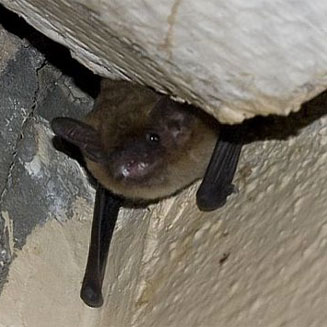|
Neoromicia capensis (Cape serotine bat)
Kaapse dakvlermuis [Afrikaans]; Kap-Breitfliigelfledermaus [German]; serotine du
Cap [French]
Life
>
Eukaryotes >
Opisthokonta >
Metazoa (animals) > Bilateria > Deuterostomia >
Chordata > Craniata > Vertebrata (vertebrates) >
Gnathostomata (jawed vertebrates) > Teleostomi (teleost
fish) > Osteichthyes (bony fish) > Class:
Sarcopterygii (lobe-finned fish) > Stegocephalia
(terrestrial vertebrates) > Reptiliomorpha > Amniota >
Synapsida (mammal-like reptiles) > Therapsida > Theriodontia
> Cynodontia > Mammalia (mammals)
> Placentalia (placental mammals) > Laurasiatheria
> Chiroptera (bats) > Microchiroptera (insect-eating
bats) > Family: Vespertiliondae (vesper bats) > Subfamily: Vespertilioninae
 |
|
|
Neuromicia capensis, Buffelsfontein Game
Reserve, South Africa. [photo Trevor Hardaker ©] |
|
Identification
A common and hardy species, the Cape Serotine
bat is small, with relatively short ears and a tail enclosed
entirely by a membrane. The head has a straight profile. Colour on
average is yellowish-brown on the upperparts and lighter on the
underparts (yellowish white), but varies widely from light to dark
brown. Wing and tail membranes are dark brown. Females are larger
than males. It is difficult to identify the different serotine bats
in the field, as Somali, Cape and Melck’s Serotine bats look very
similar.
Size
Body length 8.5 cm; forearm length 3.2 cm;
wingspan 24 cm; mass 6.5 g
Dental formula
I C C P P M M =
32 =
32
Distribution and Habitat
Occurs widely throughout sub-saharan Africa. In
the southern African subregion it is not recorded from the coastal
Namib Desert. It has a broad habitat tolerance, ranging from desert
to forest.
General behaviour
The Cape Serotine bat occurs in small groups of
2 – 20 animals, roosting tucked together in smaller groups of 2-3.
During the day, they roost in rock crevices, under the bark of
trees, at the base of aloe leaves and frequently in roofs. They
emerge at dusk and fly along set flight paths at about 10-15 m above
ground, characteristically turning and jinxing in flight while
aerial hawking in pursuit of prey.
All African insectivorous bats communicate and
navigate using echolocation. Emitting emit high frequency,
ultrasonic clicks and squeaks through the mouth or nostrils, they
use the echoes bounced back to get a “picture” of their surroundings
and any obstacles in their path.
Food
Their diets vary according to region but
primarily consist of
beetles,
lacewings,
moths,
bugs and
flies. They are attracted to insects around lights and are one
of the most commonly seen small bats flying at dusk.
Reproduction
Females give birth once a year in late November
after an 84 day gestation period. While twins are common, triplets
and occasionally quadruplets are born. The mother gives birth in a
horizontal position holding onto the roof with her toe claws and a
wing claw and catches the pup in her tail and wing membranes. Most
bat pups are born with adult sized feet and deciduous teeth to
enable them to cling tightly to the fur on their mother’s underside.
The young may be carried for 1 –2 weeks while the mother forages but
after this they are left in nursery clusters. When she returns with
food she identifies her baby.
Predators, parasites and commensals
Bats natural mortality is high during their
first year, but declines to a very low level in subsequent years.
The natural predators of bats include
snakes,
owls,
crows, other birds of prey,
genets, domestic cats and
humans. The
bat hawk is a specialized predator of bats.
Conservation
Throughout the world many bat populations are
declining. Currently the Cape Serotine bat has low risk conservation
status and is not considered threatened. Locally they may be
considered a nuisance when they roost in the roofs of urban houses.
As a result of their insectivorous diet they are susceptible to
declining from reduced insect populations that are the result of the
indiscriminate use of garden and agricultural pesticides.
Text by Denise Hamerton |
